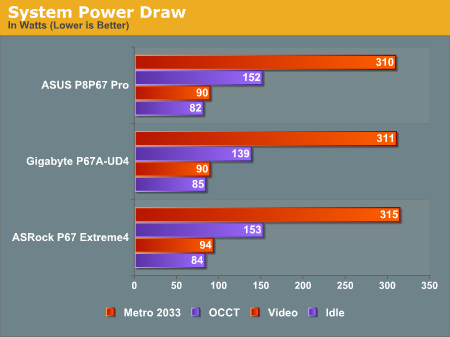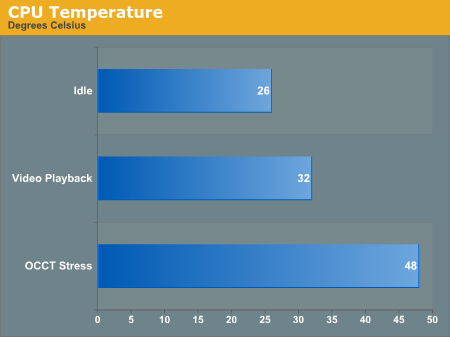Welcome to Sandy Bridge, with the ASRock P67 Extreme4
by Ian Cutress on January 3, 2011 7:00 AM EST- Posted in
- Motherboards
- ASRock
Overclocking
Overclocking on Sandy Bridge is significantly easier than on previous platforms. With only the multiplier to play with, it is a case of finding the correct balance of multiplier and voltage.
Using the AXTU software bundled with the motherboard, I simply pushed the multiplier up to 44x (4.4GHz) without any issues. At this speed, the CPU would declock to 4.0GHz when OCCT was running, indicating that we were hitting the power draw limit automatically determined by the motherboard. On 4.5GHz, the system would BSOD when starting the OCCT stress tool, indicating that not enough voltage was being supplied to the processor.
In the UEFI, due to the auto overclocking settings offered, I set the system to boot at 4.6GHz. In the OS, this set a voltage of 1.378V, and ran an OCCT stress test fine, showing a maximum temperature of 70ºC (Idle 37ºC). At the 4.8GHz setting, we got 1.49V through the processor, but a failed OCCT stress test. On the next boot, I had to reset the UEFI to get it to stay stable while changing settings.
In my wisdom, and by delving into the UEFI settings, I ventured forth to manipulate the multiplier and voltages personally. I booted into Win7 with 4.5GHz, 1.4V on VCore and 1.9V on CPU PLL (for some headroom), and turned off Load Line Calibration. However, the OCCT stress test also resulted in the CPU declocking automatically. In order to get this to stop, I had to turn on Intel SpeedStep, and increase the Long Duration Power Limit from 95W to 110W. With this, I hit 4.6GHz and 4.7GHz (hitting 73 ºC, and reducing to 4.6GHz so I increased the power to 120W). For 4.8GHz, I pushed VCore to 1.45V, and the power limits to 150W (short) and 130W (long)—this gave a stable OCCT at 80ºC but would randomly BSOD. At these settings, 4.9GHz would not boot into the OS, and I was not willing to push them further.
4.6GHz using the UEFI settings seems like the best bet for any user wanting a simple 24/7 overclock. The 3D Movement multithreaded benchmark rose from a stock score of 341.74 to 451.84.
Power Consumption and CPU Temperatures
Power consumption was tested on the system as a whole with a wall meter connected to the power supply, using a dual GPU configuration. This method allows us to compare the power management of the UEFI and the board to supply components with power under load, and includes typical PSU losses due to efficiency. These are the real world values that consumers may expect from a typical system (minus the monitor) using this motherboard.


The Extreme4 doesn't do too badly in power consumption readings compared to the other boards. It ends up slighly higher under heavy loads, but the differences are small enough that we can't see power requirements being a selling point one way or another yet.










55 Comments
View All Comments
Wander7 - Monday, January 3, 2011 - link
Still using "ATI" on the motherboard.. I guess they don't want to use "AMD" or didn't get the memo.anandskent - Monday, January 3, 2011 - link
Why are there no results for the overclocked system in the benchmarks for either the SNB CPU article or this mobo article?Also, isnt that a fan header by the 8pin cpu power? it would make the board have 6 total then
IanCutress - Wednesday, January 5, 2011 - link
The 3D Movement multithreaded benchmark was tested at the 4.6 GHz overclock. This is mentioned in the text, and in the graph for that benchmark.And yes indeed, that is a 6th fan header. It has no fan control in the UEFI or OS.
Ian
justaviking - Monday, January 3, 2011 - link
"the H series taking advantage of the graphics on the processor die"Sorry if I missed this, but I wanted to be sure on something obvious.
P-series = No onboard graphics, discrete only. That's clear.
H-series = Onboard graphics... but can it ALSO USE DISCRETE GRAPHICS???
Maybe it's so boneheaded it wasn't worth pointing out. Maybe I should have a second cup of coffee.
sviola - Monday, January 3, 2011 - link
From what I understood, none have on-board graphics, and the H series is designed to use the on-chip (CPU) graphics, while the P series is designed for discrete graphics (altough you can use the on-chip graphics as well).justaviking - Monday, January 3, 2011 - link
Thanks. That is what I assumed, but I didn't see it explicitly spelled out.P.S.
Sorry about the sloppy terminology. I mean "on-chip" when I wrote "on-board". I understand the difference. Thanks being gentle with me.
evilspoons - Monday, January 3, 2011 - link
Not quite. If you Anand's article from today about Sandy Bridge, I got the opposite impression.P can not use the on-CPU graphics at all but supports full overclocking of CPU and memory. H can use on-CPU or discrete graphics (or both simultaneously, it would seem), but only supports memory overclocking. Z is meant to fix that by allowing full overclocking and including the "FDI" (flexible display interface) needed to access the on-CPU graphics processor.
bah12 - Monday, January 3, 2011 - link
What I'm confused about is this. The K series gives us the faster GPU, and the ability to fully overclock the cpu. However you cant use the GPU since the whole reason for getting the K sku is the overclock, thus the P series board and no GPU.Where does this leave QuickSync (arguably the top selling point)? From what I understand we cannot have a fully overclocked QuickSync CPU right?
ericore - Tuesday, January 4, 2011 - link
Overclock option is only for CPU + Discreet GPU (limitation of a current motherboards; a stupid one at that; cheap Intel bast****)QuickSync comes with i5 and greater regardless of the motherboard (it is an instruction set; all of which are built-in to CPU)
I want want AMD Bulldozer to kill your royal heighness, and bring hardware market back to democracy.
vol7ron - Monday, January 3, 2011 - link
You forgot to mention that P allows for SLI/x-Fire, whereas H does not (since it only supports one discrete gpu).